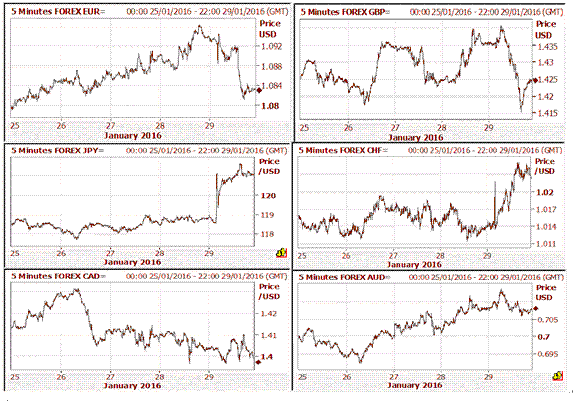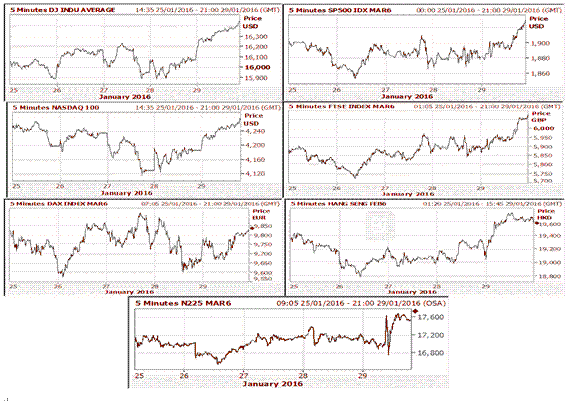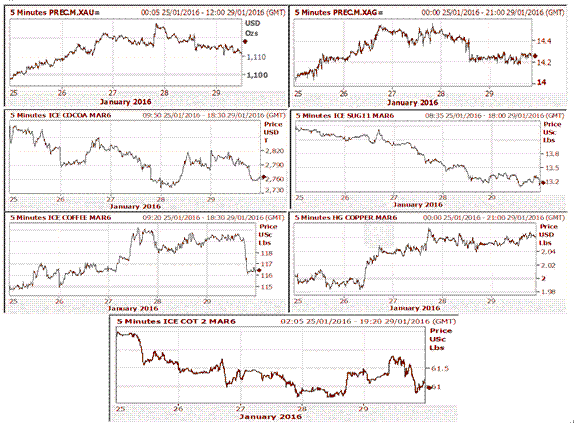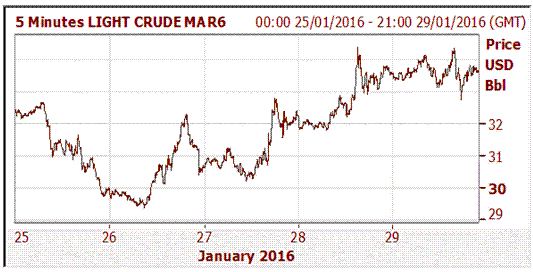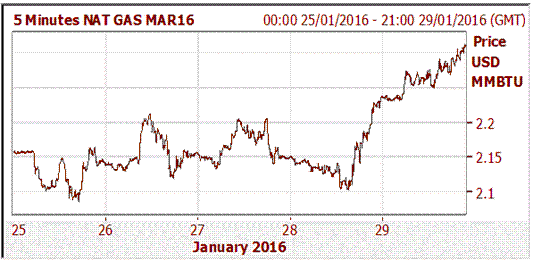FOREX
Forex – The dollar edged down on Monday as renewed selling on oil markets drove investors into their safe havens of choice, the euro and yen, and weakened the currencies of major crude exporters. After an upbeat session in Asia, stock markets quickly turned negative in Europe and oil fell almost 3 percent, driving roughly half-percent falls in the Canadian dollar. The oil price fall turned investors' focus back onto the broadly negative view of the outlook for the world economy that has dominated since the start of 2016. That has tended to benefit the euro, yen and Swiss franc at the expense of the dollar.
The dollar continued to edge lower against a basket of major currencies on Wednesday as oil declined and investors awaited the Federal Reserve's statement for clues on whether bets on a single U.S. interest rate rise in 2016 are justified. Fed fund futures are implying markets expect just one rate hike this year, compared with four according to Fed policymakers' guidance. That has put the main focus on what the Fed says after a two-day policy review that started Tuesday. A more aggressive path of rate increases would boost U.S. short-term rates, which would likely help the dollar against lower-yielding currencies such as the yen or euro.
The dollar rallied by more than 1% against the yen on Friday after the Bank of Japan surprised global financial markets by slicing its key lending rate to below 0%. The reaction in the forex market sent USD/JPY to a 6-week high, ensuring a second week higher for the dollar against the yen. Month-end pressure on the euro compromised some of its gains this week, but the combination of the dovish FOMC statement with a huge miss on U.S. durable goods orders gave the EUR/USD a slim gain of 0.3%. The Canadian dollar continued to trade lock-step with oil, ending a second week higher against the dollar with oil up from last Friday's close.
INDICES
Indices – A renewed slump in oil prices due to a persistent global supply glut hurt U.S. and European stock markets on Monday and weighed on the dollar following a rebound in those sectors late last week. The Dow Jones industrial average was down 0.52 percent, the S&P 500 was 0.67 percent and the Nasdaq Composite was down 0.56 percent.
Wall Street stocks and the dollar fell continued to fall on Wednesday as the Federal Reserve held U.S. interest rates unchanged, as expected, and said it was closely monitoring global economic and financial developments. The Fed's more cautious outlook reduced the likelihood it would raise rates by a quarter-point four times this year, which hurt the greenback, but its latest assessment on the economy did not wipe out the chances of a possible rate increase in March, which disappointed some stock investors.
Stocks jumped worldwide and the yen slumped on Friday after the Bank of Japan stunned markets by adopting negative interest rates, while hopes the Federal Reserve will slow the pace of future U.S. rate hikes also underpinned stock gains. The BOJ unexpectedly cut a benchmark rate below zero in a bold move to stimulate the Japanese economy. Volatile markets and slowing global growth have threatened the central bank's efforts to overcome deflation. Equities surged globally, the yen tumbled and sovereign debt rallied after the BOJ said it would charge 0.1 percent for excess reserves, an aggressive policy pioneered by the European Central Bank. The BOJ said it may cut rates further if necessary. A sharp braking of U.S. economic growth in the fourth quarter also raised expectations that the Fed will not be able to hike rates four times this year as it has indicated. The Dow Jones industrial average closed 2.47 percent higher; the S&P 500 gained 2.48 percent and the Nasdaq Composite rose 2.38 percent.
COMMODITIES
Commodities – Gold rose 1 percent on Monday as the dollar edged lower on renewed weakness in oil and stock markets, with concerns over the global economic outlook raising questions about the U.S. Federal Reserve's pace of interest rate tightening. The Federal Open Market Committee will meet Tuesday and Wednesday, and is widely expected to leave its federal funds rate unchanged at 0.25-0.50 percent. Gold turned positive and rose to a 12-week high on Wednesday, after the U.S. Federal Reserve held interest rates steady as expected. Gold held near its highest level since November early on Thursday after the Federal Reserve said it was closely eyeing the global economy amid weakness seen from China to Europe. After keeping U.S. interest rates unchanged as expected, Fed policymakers said the economy was still on track for moderate growth and a stronger labour market even with "gradual" rate increases.
Cocoa futures fell 2 percent in heavy volume on Monday, back toward multi-month lows on bigger-than-expected bean arrivals in top grower Ivory Coast and abundant nearby supplies, pushing the spot spread in London to a contract low. Sugar tumbled in late-day dealings, pressured by subdued physical trade and prospects for a big 2016-17 harvest in Brazil, while coffee was little changed. Sugar futures sank to a 3-1/2-month low on Wednesday, falling sharply through key technical support and spurring long liquidation, while Coffee surged on short-covering, rising for the fifth straight session above last week's two-year low. Sugar futures fell 3 percent in heavy volume to the lowest in nearly four months on Thursday, pressured by chart-based selling and weak cash prices, pushing the spot spread to a discount for the first time since September.
While tumbling sugar prices bucked the firm tone in other major commodity markets, cocoa futures prices benefited from the broad based rally, rebounding up from multi-month lows.
Henyep Investment (UK) Ltd is a company of the Henyep Financial Group and is authorised and regulated by the Financial Conduct Authority (FCA)
ENERGY
Crude Oil – U.S. oil prices recoiled 6 percent on Monday, slipping below the pivotal threshold in post-settlement trade, after news that Iraq's output reached a record last month returned attention to a market glut that sent prices to 12-year lows last week.
Oil futures surged on Wednesday after Russia indicated there was a possibility of co-operation with OPEC, fanning hopes for a deal to reduce a global oversupply that sent prices to their lowest levels in over a dozen years last week. A statement from Russia's energy ministry left the door open to talks with OPEC, moments after the head of Russia's pipeline monopoly said officials have decided they should talk to Saudi Arabia and other OPEC members about output cuts. This bullish sentiment was quickly reversed during the Thursday Asian trading session as traders digested the U.S. energy department’s report that crude stockpiles in the country grew by 8.4 million barrels in the week ended Jan. 22. While many analysts attribute the jump to seasonal maintenance at refineries rather than shrinking global demand, the data nevertheless points to a greater imbalance between supply and demand. The latest growth puts total U.S. crude inventories at 494.9 million barrels, at levels not seen in about 80 years.
Oil prices rose on Friday on support from firmer stock markets, lifted by weak U.S. gross domestic product growth data that raised hopes the Federal Reserve may slow any planned interest rate hikes. The oil market rallied for four straight sessions after a renewed call from the Organization of the Petroleum Exporting Countries for joint efforts with rival producers to cut supply triggered a volley of comments from Russia on a deal with the cartel, something it had been refusing to do for 15 years.
Natural Gas – U.S. natural gas futures eased early on Monday, in the wake of a record-breaking blizzard in the mid-Atlantic region, as forecasts called for less cold weather for the next two weeks and for the rest of the winter.
After edging up 2 percent last week, front-month gas futures on the New York Mercantile Exchange were down 2.29 percent.
U.S. natural gas futures on Thursday were nearly unchanged for an eighth straight day despite a slightly bigger than expected storage draw and mixed forecasts calling for warmer than normal to seasonal weather over the next two weeks. The U.S. Energy Information Administration said utilities pulled 211 billion cubic feet of gas out of storage during the week ended Jan. 22, the biggest draw since last February.
U.S. natural gas futures ended up more than 5 percent on Friday in a short covering rally on forecasts for colder weather through the middle of February that should boost heating demand. After trading within a few cents of unchanged for eight straight days, front-month gas futures on the New York Mercantile Exchange closed up 5.3 percent. That put the front month up over 7 percent for the week for its second weekly gain in a row but down over 1 percent for the month.
The information set forth herein was obtained from sources which we believe to be reliable, but its accuracy cannot be guaranteed. It is not intended to be an offer, or the solicitation of any offer, to buy or sell the products or instruments referred herein. Any person placing reliance on this commentary to undertake trading does so entirely at their own risk.
Recommended Content
Editors’ Picks
EUR/USD holds above 1.0750 to start the week

EUR/USD trades in positive territory above 1.0750 in the European session on Monday. The US Dollar struggles to find demand following Friday's disappointing labor market data and helps the pair hold its ground.
GBP/USD edges higher toward 1.2600

Following Friday's volatile action, GBP/USD pushes higher toward 1.2600 on Monday. Soft April jobs report from the US and the modest improvement seen in risk mood make it difficult for the US Dollar to gather strength.
Gold rebounds above $2,310 after downbeat NFP data, eyes on Fedspeak

Gold price trades in positive territory above $2,310 after closing the previous week in the red. The weaker-than-expected US employment data have boosted the odds of a September Fed rate cut, hurting the USD and helping XAU/USD find support.
Addressing the crypto investor dilemma: To invest or not? Premium

Bitcoin price trades around $63,000 with no directional bias. The consolidation has pushed crypto investors into a state of uncertainty. Investors can expect a bullish directional bias above $70,000 and a bearish one below $50,000.
Week ahead: BoE and RBA decisions headline a calm week

Bank of England meets on Thursday, unlikely to signal rate cuts. Reserve Bank of Australia could maintain a higher-for-longer stance. Elsewhere, Bank of Japan releases summary of opinions.
